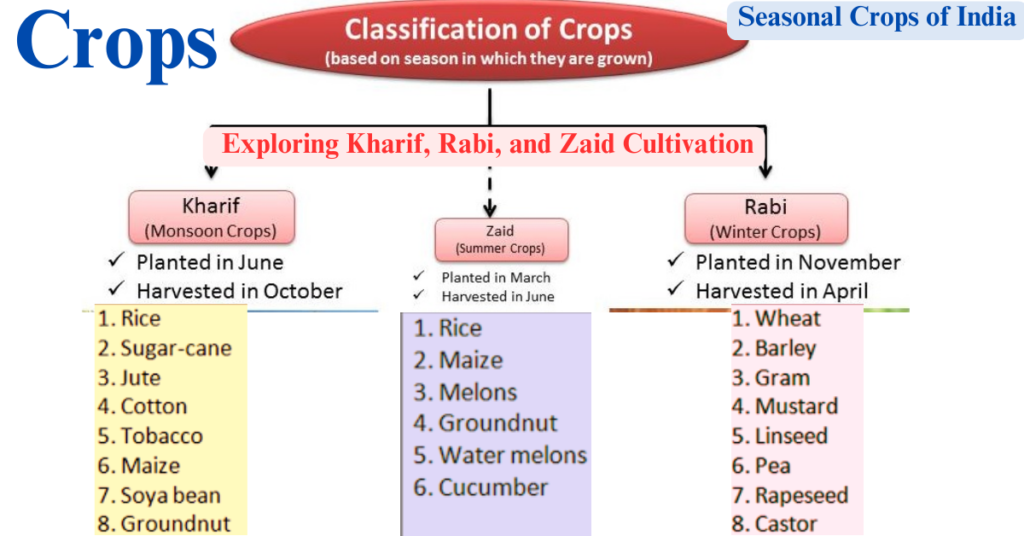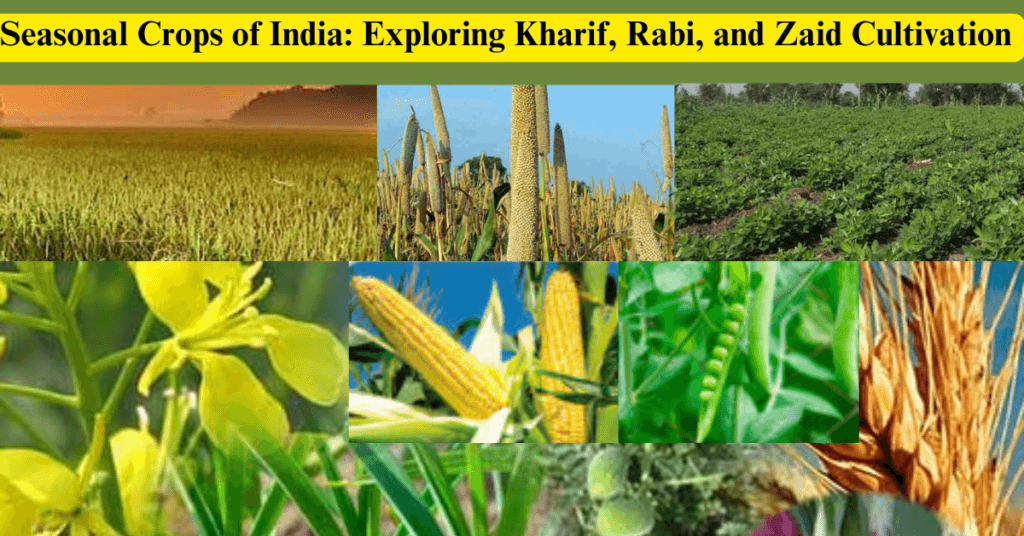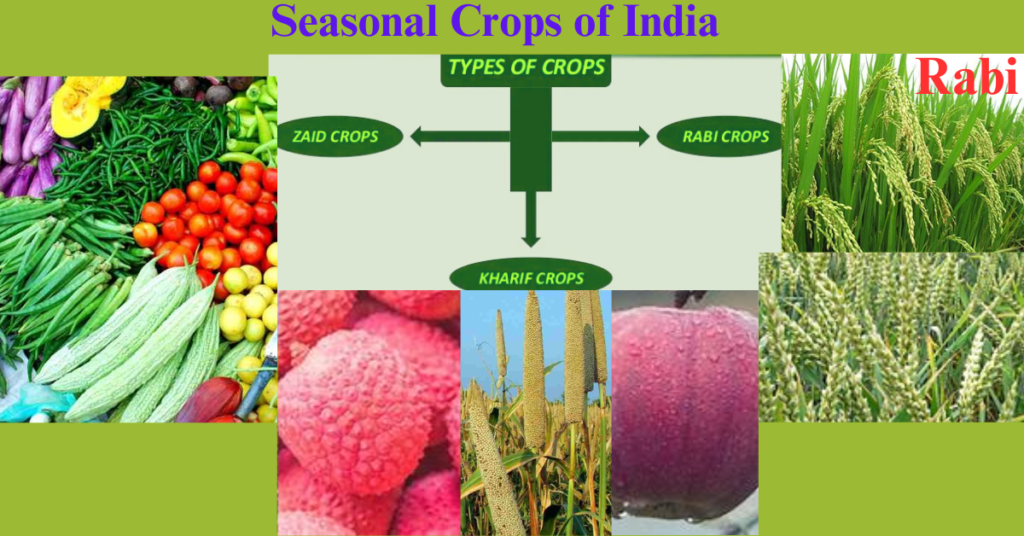
Table of Contents
Seasonal Crops of India: Exploring Kharif, Rabi, and Zaid Cultivation

“Seasonal Crops of India: Exploring Kharif, Rabi, and Zaid Cultivation” in this we deal into the diverse agricultural landscape of India, categorizing crops based on their growing seasons. It covers Kharif crops (monsoon-dependent and grown from June to autumn), Rabi crops (winter-grown and harvested in spring), and Zaid crops (cultivated between Rabi and Kharif seasons).
Introduction
India, a country with a rich agricultural tradition, enjoys diverse climatic conditions that support the cultivation of a wide array of Seasonal crops. The agricultural sector forms the backbone of the Indian economy, providing employment to a significant portion of the population and contributing substantially to the GDP. Crops in India are primarily categorized based on the seasons they are grown in: Kharif, Rabi, and Zaid. Each of these cropping seasons has its unique characteristics, cultivation practices, and crop varieties. In this article Immerse into the specifics of Kharif, Rabi, and Zaid crops, highlighting their importance, challenges, and the sustainable practices associated with them.

Kharif Crops
Kharif crops, also known as monsoon crops, are sown at the beginning of the monsoon season, usually around June, and harvested in autumn. These crops rely heavily on the southwest monsoon rains.
Major Kharif Crops
- Rice: Rice is the staple food for a significant part of the Indian population. Major rice-producing states include West Bengal, Uttar Pradesh, Andhra Pradesh, and Punjab. India is one of the largest producers and exporters of rice globally.
- Maize: Maize, or corn, is another significant Kharif crop. It is extensively grown in states like Karnataka, Madhya Pradesh, and Uttar Pradesh. Maize is used both as food and fodder.
- Sorghum (Jowar): Sorghum is an important cereal crop grown in states like Maharashtra, Karnataka, and Andhra Pradesh. It is known for its drought-resistant properties.
- Bajra (Pearl Millet): Bajra is widely cultivated in Rajasthan, Gujarat, and Haryana. It is a hardy crop, suitable for arid and semi-arid regions.
- Cotton: Cotton is a crucial cash crop in India, primarily grown in Maharashtra, Gujarat, Andhra Pradesh, and Punjab. India is one of the largest producers of cotton in the world.
- Groundnut: Groundnut, or peanut, is an important oilseed crop grown in Gujarat, Tamil Nadu, Andhra Pradesh, and Karnataka.
- Soybean: Soybean is a significant oilseed crop cultivated mainly in Madhya Pradesh, Maharashtra, and Rajasthan.
- Pulses: Various pulses such as tur (pigeon pea), urad (black gram), and moong (green gram) are grown during the Kharif season. Major pulse-producing states include Maharashtra, Madhya Pradesh, and Uttar Pradesh.
Importance of Kharif Crops
Kharif crops are vital for the Indian economy due to their contribution to food security and export earnings. The monsoon rains play a crucial role in determining the yield and productivity of these crops. Good monsoon seasons typically result in bumper harvests, leading to lower prices and increased export potential.
Challenges
The cultivation of Kharif crops faces several challenges, including:
- Dependence on Monsoon: The heavy reliance on monsoon rains makes Kharif crops vulnerable to droughts and floods.
- Pests and Diseases: High humidity during the monsoon season can lead to the proliferation of pests and diseases.
- Infrastructure: Inadequate irrigation and storage facilities can affect crop yields and post-harvest losses.
Rabi Crops
Rabi crops are sown in the winter season, typically from October to December, and harvested in the spring, from April to June. These crops rely on the residual moisture in the soil from the monsoon rains and supplemental irrigation.
Major Rabi Crops
- Wheat: Wheat is the second most important staple food in India after rice. Major wheat-producing states include Uttar Pradesh, Punjab, Haryana, and Madhya Pradesh.
- Barley: Barley is grown in states like Rajasthan, Uttar Pradesh, and Madhya Pradesh. It is used for food, fodder, and brewing purposes.
- Mustard: Mustard is a significant oilseed crop cultivated in Rajasthan, Haryana, Madhya Pradesh, and Uttar Pradesh.
- Gram (Chickpea): Gram is a major pulse crop grown in Madhya Pradesh, Uttar Pradesh, Rajasthan, and Maharashtra.
- Peas: Peas are grown in states like Uttar Pradesh, Punjab, and Madhya Pradesh. They are used both as a vegetable and a pulse.
- Lentil (Masoor): Lentil is another important pulse crop cultivated in Madhya Pradesh, Uttar Pradesh, Bihar, and West Bengal.
- Oats: Oats are grown in states like Uttar Pradesh, Punjab, and Haryana, mainly for fodder purposes.
Importance of Rabi Crops
Rabi crops are crucial for maintaining food security during the non-monsoon months. The use of irrigation systems and modern farming techniques has significantly improved the yield and productivity of Rabi crops. Wheat, in particular, plays a vital role in India’s food grain supply.
Challenges
Rabi crops face several challenges, including:
- Climate Variability: Unseasonal rains, frost, and temperature fluctuations can adversely affect Rabi crop yields.
- Irrigation: Dependence on irrigation systems makes Rabi crops vulnerable to water shortages and inefficient water management practices.
- Soil Fertility: Continuous cultivation of Rabi crops can lead to soil fertility depletion, requiring effective soil management practices.
Zaid Crops
Zaid crops are grown in the short season between the Rabi and Kharif crops, typically from March to June. These crops are mainly grown using irrigation.
Major Zaid Crops
- Watermelon: Watermelon is a popular Zaid crop grown in states like Uttar Pradesh, Rajasthan, and Punjab.
- Cucumber: Cucumber is widely cultivated in states like Uttar Pradesh, Punjab, and Haryana.
- Muskmelon: Muskmelon is another important Zaid crop grown in states like Uttar Pradesh, Punjab, and Haryana.
- Pumpkin: Pumpkin is grown in states like Uttar Pradesh, Bihar, and West Bengal.
- Bitter Gourd: Bitter gourd is cultivated in states like Uttar Pradesh, Bihar, and West Bengal.
Importance of Zaid Crops
Zaid crops provide an additional source of income for farmers between the main cropping seasons. They also contribute to the overall food supply and nutritional security. The cultivation of Zaid crops helps in the efficient utilization of land and water resources.
Challenges
Zaid crops face several challenges, including:
- Water Availability: Dependence on irrigation makes Zaid crops vulnerable to water shortages.
- Pest and Disease Management: High temperatures during the Zaid season can lead to increased pest and disease incidence.
- Market Access: Farmers may face challenges in accessing markets and obtaining fair prices for their produce.
Sustainable Agricultural Practices
To address the challenges faced by Kharif, Rabi, and Zaid crops, sustainable agricultural practices are essential. These practices include:
- Integrated Pest Management (IPM): IPM involves using a combination of biological, cultural, and chemical methods to manage pests and diseases.
- Crop Rotation: Crop rotation helps maintain soil fertility and reduces pest and disease incidence.
- Organic Farming: Organic farming practices reduce the reliance on chemical inputs and promote soil health.
- Water Management: Efficient water management practices, such as drip irrigation and rainwater harvesting, can improve water use efficiency.
- Soil Health Management: Regular soil testing and the use of organic amendments can improve soil health and fertility.
Government Initiatives
The Indian government has implemented several initiatives to support farmers and promote sustainable agriculture, including:
- Pradhan Mantri Fasal Bima Yojana (PMFBY): This crop insurance scheme provides financial support to farmers in the event of crop failure due to natural calamities, pests, and diseases.
- Pradhan Mantri Krishi Sinchayee Yojana (PMKSY): This scheme aims to improve irrigation infrastructure and ensure efficient water use.
- Soil Health Card Scheme: This initiative provides farmers with soil health cards that contain information on soil nutrient status and recommendations for soil health improvement.
- National Food Security Mission (NFSM): The NFSM aims to increase the production of rice, wheat, pulses, and coarse cereals through area expansion and productivity enhancement.
Conclusion
India’s diverse climatic conditions and topography allow for the cultivation of a wide range of crops throughout the year. Kharif, Rabi, and Zaid crops each play a vital role in ensuring food security, providing livelihoods, and contributing to the economy. However, the cultivation of these crops faces several challenges, including climate variability, water availability, and pest and disease management. Sustainable agricultural practices and government initiatives are essential to address these challenges and promote the long-term viability of Indian agriculture. By adopting modern farming techniques and efficient resource management practices, India can continue to be a global leader in agricultural production and ensure food security for its population.


